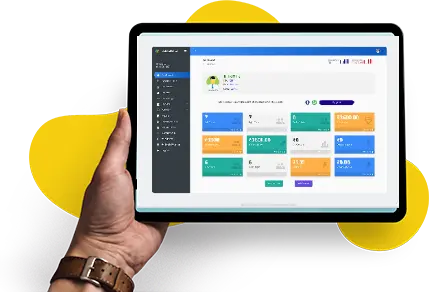MLM commissions are the core financial incentives that reward distributors for product sales and team development. They serve as the engine of most MLM business models and directly influence factors like sales performance, distributor retention, and network scalability.
In this article, we will help you understand the MLM commission structure and its different types. By the end, you will have a clear picture of how commissions drive compensation plans, their various types, key considerations, and a real-world case study to put everything in perspective.
This Article Contains:
What are MLM Commissions?
MLM commissions are the primary earnings that distributors receive as compensation for their sales efforts. This can be from the products they sell or the sales made by their team. MLM commissions form the core part of an MLM compensation plan and are typically calculated on the wholesale price of the product.
For example,
Let’s say Sarah is a distributor for a wellness company.
She buys 10 products at a wholesale price of $13 per product. Therefore, her total order amount is $130.
If her company offers a 20% personal sales commission per product, she earns $26 straightaway from her sales.
Moreover, her team generates $1,000 in total wholesale sales for the month.
If the company offers a 5% team commission, she receives an additional $50 from her downline’s sales efforts.
That means Sarah’s total earnings for the month are $26 from her personal sales plus $50 from her team’s performance, giving her $76 in commissions overall.
| Commission Type | When to Provide |
|---|---|
| Direct Sales Commission | On every personal sale a distributor makes to the end customer. |
| Retail Commissions | When products are sold directly to customers at retail price, the distributor gets a periodic payout. |
| Team Commissions | When downline members make sales or hit performance targets. |
| Rank-Based Commissions | When distributors achieve higher ranks through sales and recruitment. |
| Level Commissions | On sales made within specific levels of the downline. |
How do MLM Commissions Function in a Compensation Plan?
MLM commissions form the core part of any MLM compensation plan. The specific way these commissions are calculated and distributed is determined by the compensation plan the company chooses. However, they carry common functions and work on certain principles, such as:
1) MLM Commissions are based on Sales volume:
All MLM commissions are calculated on either personal sales volume or team volume, or both. These sales volumes are generated by selling products and services are not a part of other MLM rewards like bonuses, etc.
2) MLM Commissions are paid across several levels:
Most MLM companies reward their distributors for sales made by their recruits, and the recruits of their recruits, up to a certain number of levels within the network.
3) Rank determines commission rates:
Distributors typically unlock higher commission rates when they achieve higher ranks. This also opens up more levels of commissions or deeper generations within the network.
4) Encourage both personal and team sales:
Distributors need to constantly balance between their own sales and helping their downlines grow. This dual responsibility ultimately helps them enjoy recurring commissions in the form of team/level commissions.
5) Regular payouts:
When distributors are actively participating in sales and recruitment, it forms a steady source of income. Some distributors at the leadership level enjoy recurring income for many years, as a result of the hard work they have put in.
Types of MLM Commissions
There are various types of MLM commissions you can offer to your distributors. Each one is designed to reward them for their business-building efforts, like personal sales or team growth.
Understanding these types will help you build a balanced and motivating MLM commission structure that supports both seasoned leaders and new recruits.
1) Direct Sales Commission
Direct sales commission is the simplest type of income that a distributor can earn. It is basically the profit between the wholesale and retail price of a product.
Distributors buy the product from the MLM company at a fixed wholesale price. They sell it at the retail price set by the company and pocket the difference as their profit.
Also, this commission does not come out of the company’s compensation pool. It’s generated through retail markup and face-to-face selling. It also allows distributors to earn an income without having to wait for the company payouts.
Here’s an example to understand how it works.
Emma is a distributor with a Beauty MLM brand.
She buys a product at a wholesale price of $50.
If she sells the product at a retail price of $75, she earns $25 per product as direct sales commission.
2) Retail Commissions
Retail commissions are earned by distributors when they sell products at the suggested retail price to their customers. These MLM commissions are calculated as a percentage of the retail price of the products sold.
The major difference between retail sales commissions and direct sales commissions is that the former is paid by the MLM company to the distributors, often when sales are made offline or online through the distributor's MLM replicated websites, e-commerce links, the corporate portal, or other approved sales platforms. In such cases, the customer pays the company directly, and the distributor earns their commission afterward.
Some MLM companies only pay retail commissions if distributors hit a set Personal Volume (PV) target within a certain period. This keeps sales activity steady and rewards top performers. Also, most MLM companies put a daily/weekly/monthly cap on retail commissions earned by distributors. This keeps payouts fair to other team members and sustainable to the company.
For example,
Emma works for a Beauty MLM company that offers a 20% retail commission on every sale.
One of Emma’s customers purchased the product at the suggested retail price of $150 from her e-commerce portal.
So, $30 in retail commissions are credited to Emma’s account.
However, the company sets a target for the monthly sales of $500 to become eligible for the payout.
This means that Emma should sell products worth $350 more to become eligible for the retail commissions for that month.
Moreover, the MLM company sets a monthly cap of $2,500 on retail commissions. If Emma reaches this threshold, she will not earn additional retail commissions for that month.
3) Team Commissions
Team commissions are earnings that MLM distributors receive for recruiting, mentoring, and supporting their network of downline members. These commissions are different from direct sales and retail commissions, since they are based on the sales volume generated by the distributor’s team.
In MLM, a distributor’s team starts with them at the top as the upline, with the downline members they recruit branching out below. Each distributor is responsible for bringing in and mentoring team members, who can then build their own teams.
The structure of these teams depends on the company’s compensation plan, i.e, unilevel, binary, or matrix plan. The structure defines the width and depth of the teams that the distributors will build, ultimately resulting in the amount of team commissions they earn.
Team commissions are generally calculated by considering the business volume ( BV) of the team, which includes the combined personal volume of all eligible downline members. Also, usually the commission percentage decreases as you go deeper into the levels.
For instance:
Emma works for a beauty MLM company that uses a 3X5 matrix structure, where each member can recruit three members, and there are 5 levels in the matrix.
After 5 months with the company, Emma’s matrix has been doing well, and their sales volumes have contributed towards her team's commissions.
The table below gives a clear picture of Emma’s downline, showing the number of members at each level, their total business volume (BV), and the team commissions she earns from them for July.
| Level | Commission Rate | Number of Members | Total BV ($) | Team Commission ($) |
|---|---|---|---|---|
| 1 | 10% | 3 | 1,500 | 150 |
| 2 | 5% | 9 | 4,500 | 225 |
| 3 | 3% | 27 | 8,100 | 243 |
| 4 | 2% | 81 | 8,400 | 168 |
| 5 | 1% | 243 | 9,000 | 90 |
| Total | — | 363 | 31,500 | 876 |
So, Emma’s 3×5 matrix earns her a total team commission of $876 for July.
4) Rank-Based Commissions
Rank-based commissions are additional earnings distributors receive when they achieve specific leadership ranks in an MLM company. These ranks are tied to performance milestones such as personal sales volume, team volume, number of active downline members, or even the number of leaders in a particular distributor’s downline.
In simple words, rank-based commissions are not separate commissions. It just means an increase in the current commission percentages that distributors are already earning. These commissions motivate distributors to move up ranks by growing their network strategically and provide constant support to their downlines.
For example:
Distributor Emma joins a beauty MLM company. She starts at the consultant level and moves to the senior consultant level within 3 months.
Next, she wants to reach the “Supervisor” level. For this, she should have $2000 personal volume, $5000 team volume, and 3 active downline members, out of which one downline member should be at the senior consultant level.
After about 3 months, Emma qualifies for the Supervisor level by achieving all the milestones.
As part of her new rank, Emma’s retail commissions increase from 20% to 25%, and team commissions for each level increase by 1.5%.
5) Level Commissions
Level commissions are earnings that distributors receive based on the sales made by members in their downline, which is usually organized by levels. In MLM structures, the distributors’ personal recruits form level 1. These level 1 members further recruit their own members, forming level 2, and so on.
Level commissions are generally percentage-based and are tied to the sales volume generated by each level. The commission percentages also keep decreasing as you go deeper in the downline.
Moreover, companies offer commissions only up to certain levels to keep payouts sustainable. Higher ranks unlock more levels of commissions.
It is quite common to get level commissions mixed up with team commissions. The major difference between them is that the level commissions are earned from sales at a specific level in a downline, whereas team commissions are the total earnings from all levels combined.
Let’s take a look at one example,
Distributor Emma is at the “Supervisor” level in a beauty MLM company that employs the Unilevel MLM Plan.
According to company rules, distributors with the “Supervisor ” rank can earn commissions for up to 5 levels.
The table below will show the level commissions of each level in Emma’s team.
| Level | BV ($) | Commission Rate for each level. | Level Commission ($) |
|---|---|---|---|
| 1 | 1,500 | 10% | 150 |
| 2 | 1,700 | 5% | 85 |
| 3 | 2,000 | 3% | 60 |
| 4 | 2,100 | 2% | 42 |
| 5 | 2,500 | 1% | 25 |
Things to Take Care of While Defining Network Marketing Commission Structure
Setting up your MLM commissions is about motivating your distributors, staying on the right side of the law, and keeping your business profitable in the long run. Once you get it right, you set your business up for growth and stability. Here are a few things to keep in mind when creating your MLM commission plan:
1) Compliance with MLM Regulations and Legality
First and foremost is the compliance. It's crucial to ensure your compensation plan is fully compliant with MLM laws laid out by the Federal Trade Commission (FTC). Make sure your commissions are primarily from the sale of products or services to REAL customers, rather than from recruitment or inventory purchases by distributors themselves.
2) Aligning with Business Goals
Your MLM commission plan should align with your company’s overall goals, like increasing retail sales, expanding the distributor network, and so on. To achieve this, you should set commission percentages with the nature of the product or service, its value to the customer, and the profit margins in mind.
3) Distributor Motivation and Fairness:
Your commission structure should reward both direct sales to customers and building a productive team. Also, these should be distributed fairly based on effort, performance, and contributions. The distributors should have plenty of opportunities to earn extra bonuses and progress to higher ranks within the organization, making the plan more motivating and aspirational.
4) Financial Sustainability and profitability:
Carefully determine what percentage of revenue will be allocated to commissions and bonuses so that your company remains profitable. Factor in the costs of acquiring and retaining distributors to make sure the commission plan remains sustainable over time. This way, your business can grow steadily without being burdened by excessive payout commitments.
5) Simplicity and transparency:
Your commission structure should be straightforward enough for distributors to easily understand and explain to others. Make payout schedules, qualification criteria, and commission calculations crystal clear. If you make changes to the plan, communicate them promptly and transparently so everyone stays on the same page.
6) Technology and management:
Use specialized MLM commission software to accurately calculate, track, and manage payouts. This minimizes errors and ensures timely payments. It also allows you to analyze commission data to identify areas for improvement. The right technology can help you adapt your plan quickly as market conditions and company strategies evolve.
Case Study: Amway’s MLM Commission Structure
Amway is a well-known name in the MLM industry. This nutrition and wellness company has maintained its global presence for more than four decades by combining a strong product line with a carefully designed commission structure that motivates distributors at every level.
In this case study, we will examine Amway’s MLM commissions structure and highlight the strategies behind its success.
Amway’s compensation structure has 3 main commissions, which form its core:
Direct sales commissions
Retail commissions of 11%
Monthly commissions and sales incentives of 10%
Shared commissions starting from 3% to 25% of the team's BV.
Basically, it is a layered structure that drives both short-term and long-term motivation. While direct sales and retail sales commissions keep new distributors excited, team-based commissions motivate mid-level distributors to stay active and engaged in supporting their teams.
If you are creating an MLM commission structure for your MLM business, the key, as seen with Amway, is to strike a healthy middle ground. It is where both retail sales and recruitment efforts complement each other, while keeping new and seasoned distributors equally motivated and engaged.
Understanding the Big Picture of MLM Commissions
The right kind of network marketing commission structure can lay the groundwork for long-term stability for your MLM business. So make sure you design it with clarity and sustainability in mind.
You may not get it right the first time, so keep innovating until you find a sweet spot that motivates and retains your distributors yet keeps your MLM business profitable. In the end, your MLM commission plan will serve as the backbone of your business and ultimately define its legacy.
FAQs
1. What is the commission structure of MLM?
A typical MLM commission structure outlines how distributors earn, whether from product sales or team performance. It includes various elements like direct commissions, residual income, rank-based bonuses, etc.
2. How do residual commissions work in MLM?
Residual commissions are recurring earnings from sales made by a distributor’s downline over time. Residual earnings encourage distributors to stay active and loyal to the company, thereby reducing churn rates.
References
-
MLM.com
-
Researchgate.net
Disclaimer: Global MLM Software does not endorse any companies or products mentioned in this article. The content is derived from publicly available resources and does not favor any specific organizations, individuals or products.









